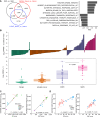MYBL2 Drives Prostate Cancer Plasticity: Inhibiting Its Transcriptional Target CDK2 for RB1-Deficient Neuroendocrine Prostate Cancer
- PMID: 39113611
- PMCID: PMC11368174
- DOI: 10.1158/2767-9764.CRC-24-0069
MYBL2 Drives Prostate Cancer Plasticity: Inhibiting Its Transcriptional Target CDK2 for RB1-Deficient Neuroendocrine Prostate Cancer
Abstract
Phenotypic plasticity is a recognized mechanism driving therapeutic resistance in patients with prostate cancer. Although underlying molecular causations driving phenotypic plasticity have been identified, therapeutic success is yet to be achieved. To identify putative master regulator transcription factors (MR-TF) driving phenotypic plasticity in prostate cancer, this work utilized a multiomic approach using genetically engineered mouse models of prostate cancer combined with patient data to identify MYB proto-oncogene like 2 (MYBL2) as a significantly enriched transcription factor in prostate cancer exhibiting phenotypic plasticity. Genetic inhibition of Mybl2 using independent murine prostate cancer cell lines representing phenotypic plasticity demonstrated Mybl2 loss significantly decreased in vivo growth as well as cell fitness and repressed gene expression signatures involved in pluripotency and stemness. Because MYBL2 is currently not druggable, a MYBL2 gene signature was employed to identify cyclin-dependent kinase-2 (CDK2) as a potential therapeutic target. CDK2 inhibition phenocopied genetic loss of Mybl2 and significantly decreased in vivo tumor growth associated with enrichment of DNA damage. Together, this work demonstrates MYBL2 as an important MR-TF driving phenotypic plasticity in prostate cancer. Furthermore, high MYBL2 activity identifies prostate cancer that would be responsive to CDK2 inhibition.
Significance: Prostate cancers that escape therapy targeting the androgen receptor signaling pathways via phenotypic plasticity are currently untreatable. Our study identifies MYBL2 as a MR-TF in phenotypic plastic prostate cancer and implicates CDK2 inhibition as a novel therapeutic target for this most lethal subtype of prostate cancer.
©2024 The Authors; Published by the American Association for Cancer Research.
Conflict of interest statement
No disclosures were reported.
Figures






References
-
- Hamid AA, Gray KP, Shaw G, MacConaill LE, Evan C, Bernard B, et al. . Compound genomic alterations of TP53, PTEN, and RB1 tumor suppressors in localized and metastatic prostate cancer. Eur Urol 2019;76:89–97. - PubMed
-
- Grassilli E, Salomoni P, Perrotti D, Franceschi C, Calabretta B. Resistance to Apoptosis in CTLL-2 Cells Overexpressing B-Myb is associated with B-Myb-dependent bcl-2 induction. Cancer Res 1999;59:2451–6. - PubMed
Publication types
MeSH terms
Substances
Grants and funding
LinkOut - more resources
Full Text Sources
Medical
Molecular Biology Databases
Miscellaneous

